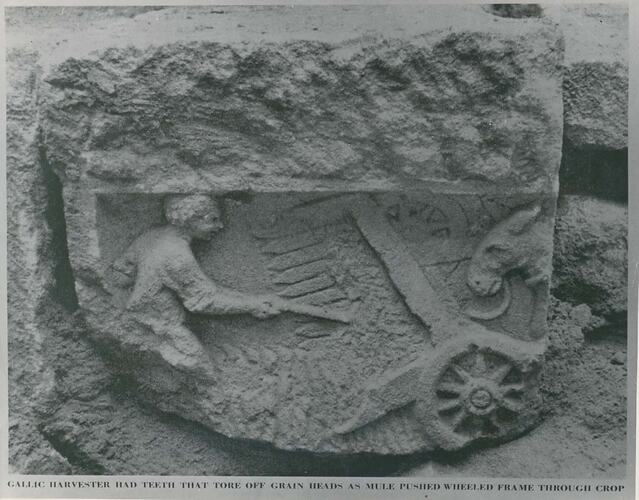Summary
Photograph of a Gallic Harvester.
According to the following extract from http://patentpending.blogs.com/ the photograph is a sculpture on a tombstone. "In Roman times a harvester was developed which was described by the historian Pliny the Elder in 77 AD. It was called the Gallic Vallus. According to Pliny, "on the vast estates in the provinces of Gaul very large frames fitted with teeth at the edge and carried on two wheels are driven through the corn by a donkey pushing from behind; the ears torn off fall into the frame."
This image is part of a collection of photographs, moving film, artefacts, documents and trade literature relating to Massey Ferguson (Aust.) Ltd, known as the H.V. McKay Sunshine Collection. The Australian operations of this company were originally founded as Hugh V. McKay in the 1890s. In 1930 it merged with Massey Harris's Australian operations to become H.V. McKay Massey Harris Pty Ltd. In 1955, this company was in turn absorbed into the Massey-Ferguson global entity becoming Massey Ferguson (Aust.) Limited.
Description of Content
According to the following extract from http://patentpending.blogs.com/ the photograph is a sculpture on a tombstone. "In Roman times a harvester was developed which was described by the historian Pliny the Elder in 77 AD. It was called the Gallic Vallus. According to Pliny, "on the vast estates in the provinces of Gaul very large frames fitted with teeth at the edge and carried on two wheels are driven through the corn by a donkey pushing from behind; the ears torn off fall into the frame." Scenes carved into stone tombstones show several views of how the first mechanised harvester worked. The teeth were rows of sharp knives, and behind the knives was a box for holding the cut corn or grain. A worker pushed the crop into the teeth of the harvester, and the harvester was pushed forward by the donkey from behind the harvester.
Physical Description
Black and white photograph
More Information
-
Collection Names
Massey Ferguson Sunshine Collection (Deposit No.1), H.V. McKay Sunshine Collection
-
Collecting Areas
-
Acquisition Information
Donation from Massey Ferguson Iseki Australia Ltd, Before 2002
-
Place & Date Depicted
-
User
Massey-Ferguson (Aust.) Ltd, Sunshine, Victoria, Australia, circa 1950s-1980s
-
Format
Photograph, Black & White
-
Inscriptions
Printed on front, 'GALLIC HARVESTER HAD TEETH THAT TORE OFF GRAIN HEADS AS MULE PUSHED WHEELED FRAME THROUGH CROP'
-
Object/Medium
Photograph
-
Classification
Agriculture & rural life, Crop management - harvesting, Header harvesters
-
Category
-
Discipline
-
Type of item
-
Image Dimensions - Photograph
255 mm (Width), 200 mm (Height)
-
Keywords

